Line 6 POD HD Desktop Owner's Manual
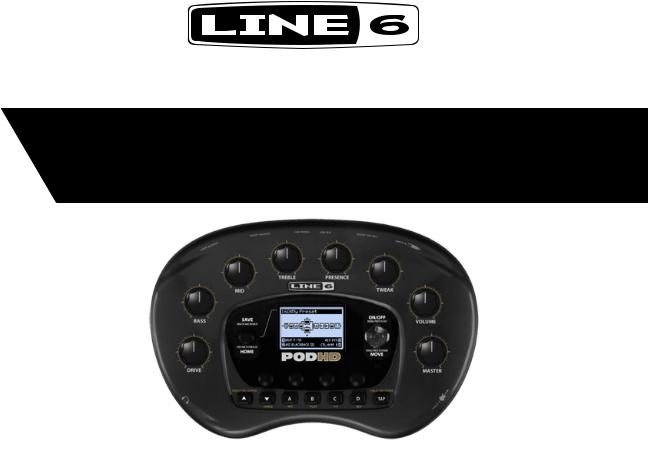
®
POD® HD
Advanced Guide
An in-depth exploration of the features & functionality of POD HD.
Electrophonic Limited Edition
Table of Contents |
|
Overview................................................................................. |
1•1 |
Home Views.................................................................................................... |
1•1 |
Tuner Mode.................................................................................................... |
1•4 |
Tap Tempo...................................................................................................... |
1•5 |
Connections.................................................................................................... |
1•5 |
POD HD Edit Software.................................................................................. |
1•6 |
System Setup.......................................................................... |
2•1 |
Accessing System Setup................................................................................. |
2•1 |
Page 1, Setup:Utilities Options...................................................................... |
2•2 |
Page 2, Setup:Utilities Options...................................................................... |
2•3 |
Page 3, Setup: Input Options.......................................................................... |
2•4 |
Page 4, Setup: Output Options....................................................................... |
2•7 |
Page 5, Setup: S/PDIF Output Options.......................................................... |
2•9 |
Page 6, Tempo Options................................................................................. |
2•10 |
Features & Functionality....................................................... |
3•1 |
FX Blocks........................................................................................................ |
3•1 |
Mixer Block.................................................................................................... |
3•3 |
Moving FX Blocks.......................................................................................... |
3•4 |
Tweak Knob Assignment................................................................................ |
3•6 |
FX & Amp Block FS Assignment.................................................................. |
3•7 |
Dynamic DSP................................................................................................. |
3•8 |
Set Lists & Presets |
.................................................................. 4•1 |
Working with Set Lists................................................................................... |
4•1 |
Working with Presets...................................................................................... |
4•4 |
Saving Presets................................................................................................. |
4•5 |
FX Edit Mode.......................................................................... |
5•1 |
Accessing FX Edit Mode................................................................................. |
5•1 |
Amp, Cab & Mic Models......................................................... |
6•1 |
Amp Model Positioning................................................................................. |
6•1 |
Selecting Amp, Cab & Mic Models............................................................... |
6•3 |
Editing Amp Parameters................................................................................. |
6•6 |
Amp & Cab Edit Display................................................................................ |
6•7 |
Amp/Preamp Models.................................................................................... |
6•12 |
Cab Models.................................................................................................. |
6•14 |
FX Models............................................................................... |
7•1 |
Dynamics Models............................................................................................ |
7•1 |
Distortion Models........................................................................................... |
7•2 |
Modulation Models........................................................................................ |
7•3 |
Filter Models................................................................................................... |
7•5 |
Pitch Models................................................................................................... |
7•6 |
Preamp+EQ Models........................................................................................ |
7•9 |
Delay Models................................................................................................ |
7•10 |
Reverb Models.............................................................................................. |
7•11 |
Volume/Pan & Wah Models......................................................................... |
7•13 |
Looper Mode........................................................................... |
8•1 |
Looper Controls & Performance View........................................................... |
8•1 |
Looper Settings............................................................................................... |
8•5 |
USB Audio............................................................................... |
9•1 |
The Line 6 USB Audio Driver....................................................................... |
9•1 |
The Line 6 Audio-MIDI Devices Panel......................................................... |
9•3 |
Mac® - Line 6 Audio-MIDI Devices............................................................. |
9•3 |
Windows® - Line 6 Audio-MIDI Devices..................................................... |
9•8 |
Appendix A: Line 6 Monkey.................................................. |
A•1 |
Launch Line 6 Monkey.................................................................................. |
A•1 |
Grab Those Updates...................................................................................... |
A•2 |
Appendix B: FBV Foot Controllers....................................... |
B•1 |
FBV MkII & FBV Series Controllers............................................................. |
B•1 |
Setup Options for FBV................................................................................... |
B•2 |
FBV Controller Devices - Footswitch & Pedal Mapping .............................. |
B•5 |
FBV Shortboard MkII..................................................................................... |
B•5 |
FBV Express MkII........................................................................................... |
B•8 |
FBV Longboard............................................................................................. |
B•10 |
FBV Shortboard............................................................................................ |
B•13 |
Expression Pedal Assignment....................................................................... |
B•16 |
Amp & FX Block Footswitch Assignment................................................... |
B•18 |
Set List Select............................................................................................... |
B•21 |
Tap Tempo.................................................................................................... |
B•22 |
Tuner Mode.................................................................................................. |
B•22 |
Line 6, POD, FBV, CustomTone and Line 6 Monkey are trademarks of Line 6, Inc. All other product names, trademarks and artists’ names are the property of their respective owners, which are in no way associated or affiliated with Line 6. Product names, images, and artists’ names are used solely to identify the products whose tones and sounds were studied during the Line 6 sound model development for this product. The use of these products, trademarks, images, and artists’ names does not imply any cooperation or endorsement.
Copyright © 2012 Line 6, Inc.

Overview
Overview
Welcome to the POD® HD Advanced Guide. This guide contains in-depth details of the |
1•1 |
POD HD features and functionality. Please be sure to also read through your POD HD Pilot’s Handbook for basic info on POD HD and this Guide will take it from there! In this chapter, we’ll present an overview of the main screens and features to get you started.
This Guide covers POD HD with Flash Memory version 2.0 (or later) installed. Please use Line 6 Monkey to check for and install the latest updates for your device - see “Appendix A: Line 6 Monkey” on page A•1.
HomeViews
SAVE
PRESETS
HOLD FOR SYSTEM & I/O
VIEW
The place to start is in one of the Home View screens. Press the VIEW button to rotate through the available Home Views. While in any of these Home View screens, you can turn the PRESETS knob and call up a Preset in the current Setlist, or push the PRESETS knob to select from among other Set Lists!
Signal FlowView
The Signal Flow View displays all Amp & FX “Blocks” and their ordering for the current Preset. As you’ll see in several of the following chapters, this is the screen where you’ll “select” the desired Block to perform other actions, such as choose a new Amp or FX Model, edit its parameters, move its position, and more.
Currently loaded Preset location and title 
Use the  and Nav.
and Nav.  Pad buttons to select the desired Block
Pad buttons to select the desired Block
FX Blocks within “Pre” position
Amp Blocks |
FX Blocks within |
“Post” position |
The items within the Signal Flow View
Parallel Paths A (upper) and B (lower) with Mixer Block
Looper
The signal flow architecture of each Preset is comprised of 3 main sections where Amp & FX Blocks can be positioned: Pre, Post and parallel Paths A & B.
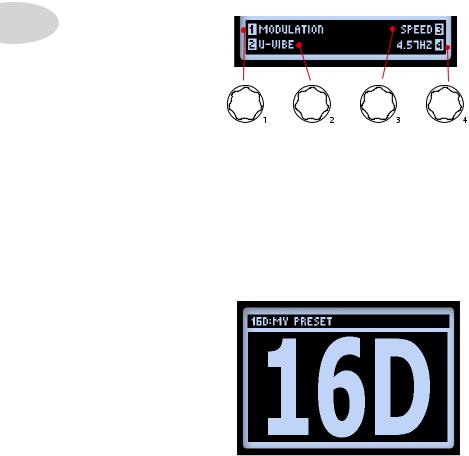
Overview
At the bottom of the Signal Flow View screen, you’ll see up to four parameters that are accessed using the Multi-function knobs 1-4.
1•2
Accessing parameters with the Multi-select Knobs
These parameters are specific to the currently selected Block and allow you to choose new Models & edit parameters. Or, you can dive deeper in the Edit Mode and access additional settings in other screens, as covered in the following chapters.
Big UserView
This screen simply provides you with one BIG display of the currently loaded Preset number - convenient for dark stages!
The Big User View

Overview
PerformanceView
This screen displays the functions available for your POD HD A, B, C & D buttons and
for Line 6 FBV™ Controller functions, if one is connected. This screen appears in three 1•3 different variations, depending on your device settings. The four options on the lower half
of the screen pertain to the A, B, C & D buttons (and to FBV footswitches A - D).
You’ll see one of the following screens appear, dictated by the current POD HD Setup - FS MODE setting - Also see “Page 1, Setup:Utilities Options” on page 2•2 for details.
“ABCD” Mode |
“FS 5-8” Mode |
When POD HD is in Looper Mode, a 3rd variation of the screen displays the Looper functions that are accessed by the A, B, C & D buttons and FBV footswitches. Also see “Looper Controls & Performance View” on page 8•1.
The Performance View with Looper Mode active
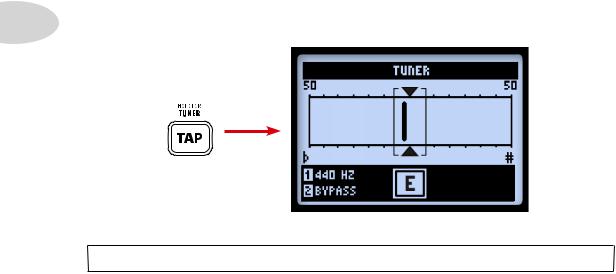
Overview
|
Tuner Mode |
1•4 |
To enter Tuner mode, press and hold the TAP button. A few options are available, adjusted |
using the Multi-function knobs. |
The Tuner screen
Note that the Tuner receives a signal only from the POD HD Input 1 source.
Pluck an individual string on your guitar and you’ll see the name of the note displayed. When the graphic bar is to the left of center, your string is flat; when it is to the right, your string is sharp. When the bar is within the center range, triangles will appear above and below it, indicating your string is in tune.
•Reference (Knob 1): If you’d like to tune to a reference other than standard 440Hz, select from 425 to 455Hz.
•Audio (Knob 2): Select Mute to silence POD HD output while tuning, or select Bypass to hear your guitar dry.
Press the TAP switch, or any other button, to exit Tuner Mode.

Overview
TapTempo
Tap Tempo is the term we use to refer to the “System Tempo” value that is
accessed via the TAP button on your POD HD device. Tap rhythmically to set 1•5 your Tempo. Alternatively, you can set a numerical Tempo value within Setup
(see “Page 6, Tempo Options” on page 2•10). This setting is saved per Preset.
You’ll see the TAP switch blink to indicate your current Tap Tempo BPM (if your Tap LED option is set to “On” - see “Page 2, Setup:Utilities Options” on page 2•3). Tempo-based FX (Modulation, Filter & Delay FX) that offer a Tempo Sync parameter can optionally be set to a note division of this Tap Tempo value.
Connections
Please refer to your POD HD Pilot’s Guide for descriptions of the Input & Output connections. You’ll find more details on their specific uses within the following chapters as well!
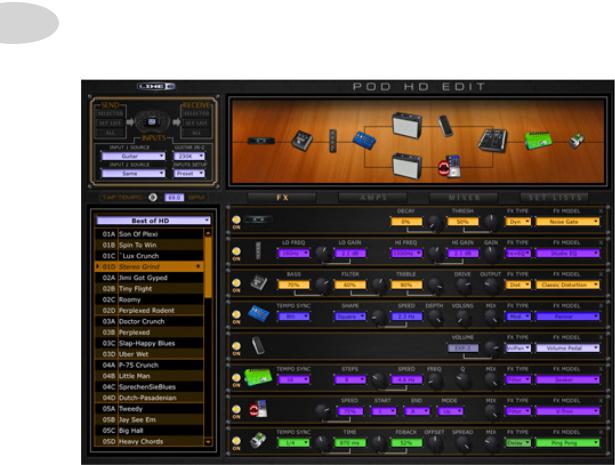
Overview
POD HD Edit Software
Be sure to visit line6.com/software to download the Line 6 POD® HD Edit software - the
1•6 free patch editor/librarian for Mac® and Windows® computers. Using POD HD Edit and a USB connection you can easily create, audition, customize, backup/restore and save an unlimited number of Tone Presets for your device.
The POD HD Edit application
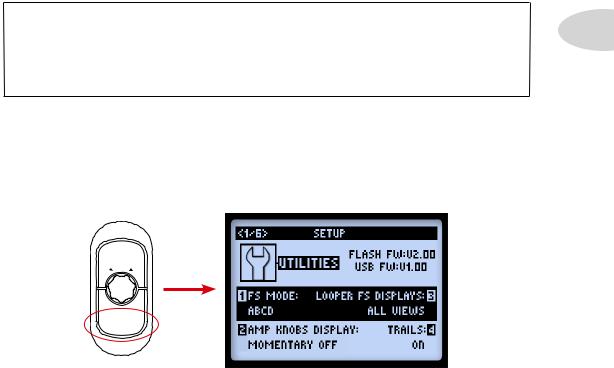
System Setup
System Setup
In this chapter, we’ll cover the options for configuring your POD® HD system settings.
Note that some System Setup options are “global” settings (they persist always, regardless of
the current Preset) while others are saved individually per Preset, as noted in the following 2•1 sections. You’ll want to be sure to save your Preset after changing settings of the latter type
in order to retain them. To restore all global settings to their factory default value, hold down the Nav. Pad - left arrow button while powering on POD HD.
Accessing System Setup
To access the System Setup options, press and hold the VIEW button. Here you can configure several device functions, Input & Output settings and more.
SAVE
PRE
S
E
TS
HOLD FOR SYSTEM & I/O
VIEW
Use the  Nav Pad buttons to navigate through the several Setup pages.
Nav Pad buttons to navigate through the several Setup pages.

System Setup
Page 1, Setup:Utilities Options
2•2
The top portion of the screen lists the Flash Memory and USB Firmware versions currently installed on your POD HD device. The lower portion of the screen offers four options, adjustable using the Multi-function Knobs 1 - 4.
•Footswitch Mode (Knob 1): This option applies to your POD HD A, B, C & D.* You’ll see your Performance View screen reflect the functions of these buttons according to the mode selected here (see “Performance View” on page 1•3). This setting is global.
•In “ABCD” Mode: The A, B, C & D buttons recall the current Bank’s Presets
A-D.
•In “FS 5-8” Mode: The A, B, C & D buttons toggle the Footswitch 5-8 assigned Models On/Off.
*Note: This also applies to a connected Line 6 FBV™ Controller’s A, B, C & D footswitches
-please see “Setup Options for FBV” on page B•2.
•Amp Knobs Display (Knob 2): When set to “On,” allows the LCD screen to momentarily display the actual Amp Tone Knob values whenever adjusting any physical amp knob. This setting is global.
•Looper FS Display (Knob 3): When Looper Mode is active, this option determines how and when the Looper screen is displayed (see page 8•1). This setting is global.
•All Views: When Looper Mode is On, the Looper screen is always displayed.
•Performance View: When Looper Mode is On, displays the Looper screen, or the other Performance View (Signal Flow or Big User) screens, by toggling the VIEW button. This option can be useful for referencing your Presets or adjusting Models while Looping.
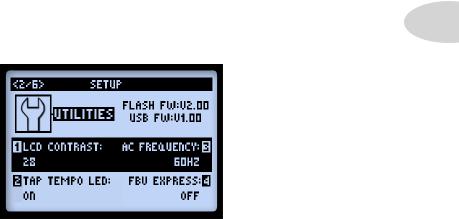
System Setup
•Trails (Knob 4): When set to “On,” allows the echo repeats and/or decay of Delay and Reverb FX to continue when the Model is toggled Off. With the Trails option “Off” the decay is muted instantly when toggling the Model Off. This setting is saved per Preset. (Note that this feature does not provide a “spillover” of the FX decay when changing Presets.)
2•3
Page 2, Setup:Utilities Options
The options at the bottom of the screen are as follows - all are global settings.
•LCD Contrast (Knob 1): Adjusts the screen’s contrast.
•Tap Tempo LED (Knob 2): Choose “On” to have the LED light for the TAP switch (or connected FBV TAP footswitch) flash to indicate the current Tap Tempo value. Choose “Off” to have it remain unlit.
•AC Frequency (Knob 3): All HD Amp Models include simulation of AC hum, typical of the AC Vacuum Tube Heater component - an important part of the tonality of a tube amplifier. Set the AC Rate to match that of the USA (60Hz) or UK (50Hz) frequency for authenticity. (This setting may be subtle depending on the current Amp Model settings, and may be more apparent when synchronizing this setting with the AC rate of any tube amplifier that POD HD may be plugged into.)
•FBV Express (Knob 4): This option applies only to a connected Line 6 FBV Controller. It should only be set to “On” specifically for a FBV Express MkII model device. Please see “Setup Options for FBV” on page B•2.

System Setup
Page 3, Setup: Input Options
The Inputs Setup page allows you to select which of the device’s audio inputs are used as the “source” – sort of like a built-in, programmable patchbay. There is also a control which adjusts the Guitar input impedance.
2•4
•Input 1 and Input 2 Source (Knobs 1 & 2) - Select the physical input(s) that you want to be the “source” which feeds into the signal path. Note that you can choose different Sources to independently feed each signal path, or choose Same to feed a common Source into both paths.
•Guitar In-Z - Select the input impedance of the Guitar input. This feature affects tone and feel because your guitar pickups are being loaded as they would be by an effect pedal or a tube amplifier.
Note: The Guitar In-Z setting affects the GUITAR IN input only. Please see the Impedance Ratings table at the end of this section to reference the input impedance of each individual model.
•The Auto option dynamically sets the input impedance to match the input impedance of the very first Amp or FX model in your POD HD signal chain.
•Or, you can manually select from a variety of impedance values from low to high
(22k, 32k, 70k, 90k, 136k, 230k, 1M, or 3.5M). A lower value will typically result in some high frequency attenuation, lower gain and overall “softer” feel. A higher value provides full frequency response, higher gain and overall “tighter” feel.
•Inputs Setup - Determines whether the other 3 options in this Inputs screen are applied per Preset, or globally.
•Preset - Recalling a preset will load the Input 1 Source, Input 2 Source and Guitar In-Z parameter settings as last saved with the individual preset.

System Setup
• Global - Once the “Global” option is selected here, the other three Input options’ values on this Setup page (Input Sources 1 and 2, and Guitar In-Z) are utilized globally, regardless of their values that are saved with each individual preset. The Input values you choose on this Setup page are then retained independently for
the Inputs Setup - Global option. When you |
change the Inputs Setup back to |
“Preset,” the Input options’ values saved with each individual preset are once |
|
again utilized. |
2•5 |
Note: Saving a preset while this option is set to “Global” will write the current global Inputs and Guitar In-Z values to the individual, saved preset.
Amp & FX Model - Guitar Input Impedance Ratings
Model |
|
Guitar Input Impedance |
|
|
(Ohms) |
Amps & Preamps |
||
All Amp & Preamp Models |
|
1M |
|
Distortion FX |
|
|
|
|
Screamer |
|
230k |
Color Drive |
|
136k |
Buzz Saw |
|
230k |
Facial Fuzz |
|
22k |
Jumbo Fuzz |
|
90k |
Fuzz Pi |
|
22k |
Octave Fuzz |
|
230k |
All Other Distortion Models |
|
1M |
|
Dynamics FX |
|
All Dynamics Models |
|
1M |
|
Modulation FX |
|
|
|
|
Dual Phaser |
|
230k |
U-Vibe |
|
90k |
Analog Choruis |
|
22k |
All Other Modulation Models |
|
1M |

System Setup
2•6
Amp & FX Model - Guitar Input Impedance Ratings
Model |
|
Guitar Input Impedance |
|
|
(Ohms) |
|
Filter FX |
|
All Filter Models |
|
1M |
|
Pitch FX |
|
All Pitch Models |
|
1M |
|
Delay FX |
|
Multi Head |
|
22k |
Analog Echo |
|
230k |
Analog w/Mod |
|
90k |
All Other Delay Models |
|
1M |
|
Preamp + EQ FX |
|
All Preamp & EQ Models |
|
1M |
|
Reverb FX |
|
All Reverb Models |
|
1M |
|
Wah FX |
|
Weeper |
|
90k |
All Other Wah Models |
|
1M |
|
Volume & Pan FX |
|
All Volume and Pan Models |
|
1M |
|
FX Loop |
|
FX Loop |
|
1M |
About Source Input Signal Routing
It is important to note how POD HD actually routes Source Inputs 1 and 2 through Amp
&FX Blocks that are positioned “Pre” position. The following behaviors apply:
•In a configuration with no Amp or FX Blocks in Pre, Input 1 is fed only to Path A and Input 2 only to Path B. Therefore, this is the best configuration if you want to retain discrete Input Sources into Paths A & B.

System Setup
•Placing an Amp Block or an active mono FX Model in Pre results in a “summing” of Input Sources 1 & 2, feeding the same, combined signal into these Pre-positioned
Models, and thus into each Path A & B. You may need to adjust your instrument’s volume level to avoid overloading your Pre-positioned Amp or FX Models.
•Placing a Stereo FX Model in Pre results in the left channel FX output being fed to
Path A and its right output to Path B.* |
2•7 |
• The Mixer Block’s Volume and Pan options provide independent control for Path |
A & B outputs before they are fed through any Blocks positioned “Post” the Mixer.
• By setting Input 2 to “Same,” this effectively routes your Input Source to both stereo
Paths A & B (which is how you can feed one guitar input into two Amp Models and/ or parallel FX, for example).
*Please also see “Model Types and Mono/Stereo Signal Routing” on page 3•5 for more about how mono and stereo FX affect your signal chain.
Page 4, Setup: Output Options
The Mode setting on this page allows you to configure the type of signal fed to your POD HD analog outputs to optimize for direct recording versus connecting to an external amplifier.
Note that this Mode setting affects the signal fed to the POD HD Left & Right main outs, Headphone outs and USB Record Send.

System Setup
|
Knob 1 selects the Output Mode. This is a global setting. |
|
• Studio/Direct: Typically the best option when connecting “Direct” to a mixing |
|
console or recording device. This signal includes “Studio” Cab Models, Mic Model |
|
and an “AIR” convolution to best emulate a mic’ed amp within a room. |
2•8 |
• Combo and Stack settings: Optimizes your tone for connecting to an external |
amplifier. The signal includes “Live” Cab Models,with no Mic Model or “AIR” |
convolution, with a special EQ curve added for each.
• Combo Front & Stack Front: For connecting into the front input of a typical combo amp or amp head + external cab, respectively. When choosing either of these Modes, you’ll see these additional options for further tone shaping:
• Lows (Knob 2): Attenuates the low frequencies.
• Focus (Knob 3): Increases the overall midrange.
• Highs (Knob 4): Attenuates the high frequencies.
• Combo Power Amp & Stack Power Amp: For connecting to the power amp of a combo or head amp.
TIP: When using the Combo or Stack options and connecting into a tube amplifier, we also recommend that you choose a Preamp Model from the Amp Model menu (rather than one of the “Full” Amp Models). HD Preamp Models include no power amp emulation, making them typically better suited for this connection. That said, there is no wrong choice! PODs have always been about flexibility... Check out all the possibilities and decide which Models work best for your tone!

System Setup
Page 5, Setup: S/PDIF Output Options
2•9
These options are strictly for configuring the signal fed to the S/PDIF OUT. Use this 24- bit digital connection when connecting to the S/PDIF input of other devices, such as a computer audio interface or digital mixing console. All settings are global.
Note: When connecting to another digital device, it is best to clock the external device to follow POD HD (with POD HD as the “master” device) to maintain proper synchronization
-please see your digital device’s documentation for its digital clock features.
•S/PDIF Output (Knob 1): Selects the type of output mode signal.
•Match Outputs: Uses the setting as configured on the Setup:Outputs screen - see page 2•8.
•Dry Input: Your Source Input signal with no Amp, Cab, Mic, “E.R.” or FX processing applied. (Handy for recording a dry signal in your DAW, to which you can add a Plug-In or “re-amp” later!)
•Sample Rate (Knob 2): Selects the sample rate: 44.1kHz, 48kHz, 88.2kHz or 96kHz.
When connecting to another device’s S/PDIF input, always be sure to set both units to utilize the same sample rate.
•S/P Level (Knob 3): Increases the amplitude of the S/PDIF signal: 0 dB.

System Setup
Page 6,Tempo Options
2•10
•Tempo Sync (Knob 3): The “Speed” or “Time” parameters of all tempo-based FX (Modulation, Pitch & Delays) can optionally be set to a note value to follow the (Knob 4) Tempo BPM value. This Tempo Sync option is a global setting that allows you to choose whether the FX follow the Tap Tempo as a per-Preset value or globally.
•Preset: Tempo settings are saved and recalled on a per Preset basis.
•Global: Tempo information stored within any Preset is ignored. When saving a Preset while this option is set to “Global,” the current tempo value will be saved with the Preset.
•Tempo (Knob 4): Enter in a specific “Tap Tempo” for your current Preset (as opposed to stomping rhythmically on the TAP button). This value is saved individually per Preset.

Features & Functionality
Features & Functionality
Ready to dive deeper? In this chapter, we’ll go into more detail on the major features & functionality offered on POD® HD.
FX Blocks
For each Preset there is always a total of 8 FX Blocks, each capable of loading any FX |
3•1 |
Model. When in the Signal Flow View screen, select any FX Block and you’ll see options |
at the bottom of the screen, adjustable using the Multi-Function Knobs 1-4.
The Signal Flow View with an FX Block selected
•Model Type (Knob 1): Select from among the FX Model categories.
•To load no effect in the selected Block, choose “None.” You’ll see the Block then appear “Null,” as shown below. A Null FX Block can still be moved and loaded with a new Model at any time. Setting unneeded FX Blocks to None is a great way to minimize your tone’s DSP usage (see “Dynamic DSP” on page
3•8).
FX Blocks with the Model set to “None”
• FX Model (Knob 2): Choose the desired Model from the Model Type list.

Features & Functionality
•FX Parameters (Knob 3): Choose from up to 5 adjustable parameters. Alternatively, double-press the ENTER button to access all the Model’s parameters in one screen - see “FX Edit Mode” on page 5•1.
•Parameter Value (Knob 4): Adjusts the value for the currently selected parameter.
|
Each FX Block also offers the following features: |
3•2 |
• On/Off: Toggle the FX Block “On” or “Off” by pressing the ENTER button once. |
When Off, your signal flows through the FX Block unprocessed. |
|
|
• Move FX Position: Each FX Block can be moved throughout the signal chain, |
|
providing complete routing flexibility. Place any FX Model before the Amp (“Pre”), |
|
after the Amp (“Post”), or within one of the parallel Paths A & B - see “Amp Model |
|
Positioning” on page 6•1 for details. |
|
• Saved Per Preset: All FX Block positions, their loaded FX Models and all FX |
|
parameter values within the tone are saved with each Preset. |
Amp Blocks
A single Amp Block can be placed in the “Pre” or “Post” signal flow positions, or within parallel “Path A.” Or, two Amps can be used if positioned within Paths A & B, as shown below. Much like FX Blocks, Amp Blocks can be toggled On/Off and include several editable parameters. But there’s quite a bit more available for Amps as well, so please refer to the dedicated chapter “Amp, Cab & Mic Models” on page 6•1 for details!
A Preset with two Amp Blocks

Features & Functionality
Mixer Block
The Mixer is permanently positioned at the end of the parallel Paths A & B and provides individual Level and Pan controls for each Paths’ output before fed to the “Post” position. When the Mixer is selected in the Signal Flow View, its four parameters are available at the bottom of the screen, accessible using the Multi-function Knobs 1-4.
3•3
The Signal Flow View with the Mixer Block selected, showing its 4 parameters
•Volume A (Knob 1): Controls the volume level of the Path A output. 0 dB is unity gain.
•Volume B (Knob 2): Controls the volume level of the Path B output. 0 dB is unity gain.
•Pan A (Knob 3): Adjusts the left/right stereo balance of the Path A output.
•Pan B (Knob 4): Adjusts the left/right stereo balance of the Path B output.
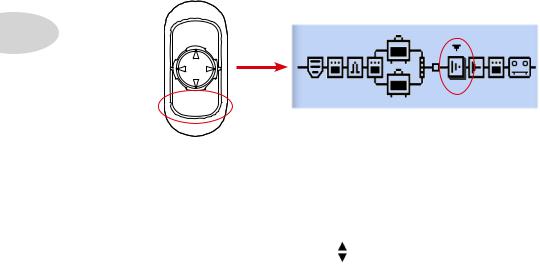
Features & Functionality
Moving FX Blocks
Any of the 8 FX Blocks can be moved throughout your tone’s signal flow, providing tremendous routing flexibility. To move any FX Block, start within the Signal Flow View and select the FX Block to be moved. Press the MOVE button and you’ll see the selected FX Block appear “raised” to indicate it is now moveable.
3•4 |
AMP & FX ON / OFF |
|
ENTER |
DBL PRESSTO ASSIGN CTL
MOVE
Pressing the Move button to reposition an FX Block
The FX Block can now be moved as follows:
•Use the  Nav. Pad buttons to move the FX Block to the desired position.
Nav. Pad buttons to move the FX Block to the desired position.
•Move the FX Block into either Path A or B, and place it before or after an Amp
Model within the path. Use the Nav. Pad buttons to move the FX Block to the opposite path. This allows you to run your effect in “parallel” and blend the individual Path A & B outputs using the Mixer’s Level & Pan options!
•Once the FX Block is in the desired position, press the MOVE button again to drop it into place.
•Amp Blocks can be moved into fixed positions within the Pre or Post signal path areas, or within the Paths A & B - see “Amp Model Positioning” on page 6•1.
•The Looper can also be selected and moved either to the start (“Pre”) or end (“Post”) of the signal flow - see “Looper Mode” on page 8•1.
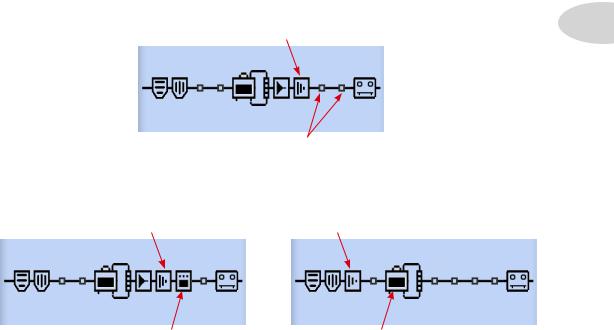
Features & Functionality
ModelTypes and Mono/Stereo Signal Routing
It is important to note that some Models (all EQs, Wahs & Volume, and some Modulations, Filters, Pitches and Delays) preserve a stereo output within the signal chain, while others (all Dynamics, Distortions, all Amps & Preamps, and other various Models) are mono FX and do not. The POD HD Inputs 1 & 2 are fed into the signal chain as stereo (see “Page 3, Setup: Input Options” on page 2•4). Therefore, wherever a mono FX or Amp Model is inserted, the Left & Right channels of this stereo signal is “mono-ized” and heard as a two-channel mono signal at the Model’s output. To follow are a few examples:
Ping Pong Delay |
3•5 |
|
No mono-output FX or Amp follows Delay
•As shown above, if you place the Ping Pong Delay (a stereo-output FX Model) after any other FX and/or Amp Models, you’ll hear its delay repeats bounce back and forth between your Left and Right outputs.
Ping Pong Delay |
Ping Pong Delay |
A Distortion (mono) FX Model follows Delay |
An Amp Model Follows Delay, within same Path |
•If you place the Ping Pong Delay immediately before a mono FX Model (as shown above, left) or Amp Model within the same Path (shown above, right), you’ll hear its delays “mono-ized,” equally through both the Left and Right outputs.
•The above rules also apply within each of the parallel Paths A and B, since these are each stereo signal paths as well. The Mixer Block offers Pan controls to independently adjust the stereo balance of each of these Paths before they are fed into the first “Post” FX (or Amp Block, if the Amp is placed here), immediately following the Mixer.
•Please also see “Amp Model Positioning” on page 6•1 for additional signal flow information.
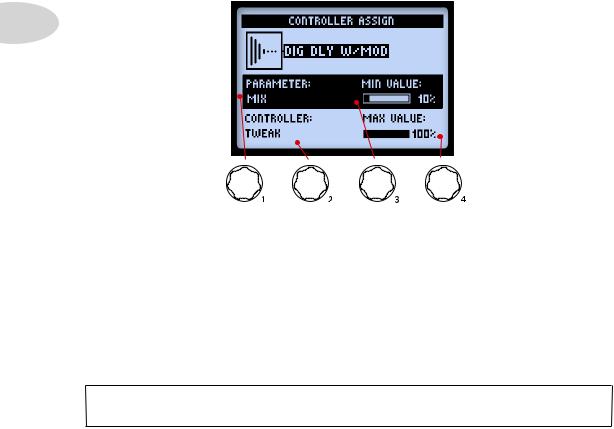
Features & Functionality
Tweak Knob Assignment
The TWEAK knob on your POD HD utilizes its own “Controller,” allowing it to be assigned to control just about any Amp or FX parameter (or multiple parameters, simultaneously). To configure the TWEAK Controller assignment, select the desired Amp or FX Block, then double-press the MOVE button to display the Controller Assign screen. These settings are all saved per Preset.
3•6
The Controller Assign screen
•Parameter (Knob 1): Select the parameter for the current Model that you want to control.* In our example, we’ll choose the Mix parameter for our Delay.
•Controller (Knob 2): Select the TWEAK Controller.*
•Minimum Value (Knob 3): Set the parameter value you’d like for the TWEAK knob’s minimum value.
•Maximum Value (Knob 4): Set the parameter value you’d like for the TWEAK knob’s maximum value.
*The EXP 1 & EXP 2 Controller options are used to create assignments for use with Line 6 FBV™ Expression Pedals - see “Appendix B: FBV Foot Controllers” on page B•1.
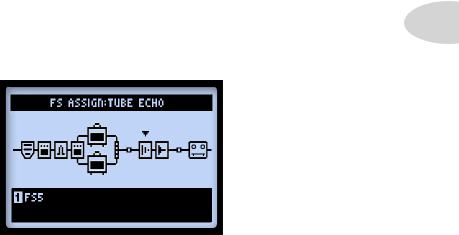
Features & Functionality
FX & Amp Block FS Assignment
Any of the FX and Amp Blocks can also be configured with a “FS” (Footswitch) assignment to remotely toggle the Block’s Model On/Off. This, of course, is of most use with a connected FBV Controller device, so we’ve covered this information in “Amp & FX Block Footswitch Assignment” on page B•18.
It is worth noting here that, when the Setup - FS MODE option (see “Page 1, Setup:Utilities Options” on page 2•2) is set to “FS 5-8,” your POD HD A, B, C & D buttons will trigger
the FS 5-8 assigned Blocks. To create and edit FS assignments, select the desired FX or 3•7 Amp Block within the Signal Flow View, then hold the VIEW button. This displays the
FS ASSIGN screen. All assignments are saved per Preset.
The Footswitch Assign screen - use Knob 1 to create or edit a Block’s FS assignment

Features & Functionality
Dynamic DSP
|
We’ve offered up a whole lot of sound possibilities in POD HD, and it can take some |
|
serious Digital Signal Processing (DSP) to run these goodies. Rather than limit your |
|
creative potential with fewer Models or signal routing options, we chose to implement a |
|
“Dynamic DSP” system, which dynamically assigns DSP resources to accommodate your |
|
tone configurations. When creating a tone that utilizes several heavy-hitting DSP Models, |
|
it is possible to surpass the amount of processing power available. In these cases, you’ll see |
3•8 |
the DSP LIMIT REACHED indicator appear, and the current Model is bypassed to allow |
your tone to remain active. |
DSP Limit alert is temporarily displayed
Currently selected Model is automatically bypassed, with DSP message shown here
Signal Flow View - displaying DSP Limit alert
In the above example, trying to change the Model for a 2nd Amp placed our tone over the DSP limit. Therefore, the DSP LIMIT REACHED message is shown temporarily, and the Amp B Model we selected is automatically bypassed, as indicated by the DSP Over message. When the DSP Limit is reached, you have a few options to free up DSP resources.
•Try using different Amp Models. Some of the HD Amp Models require more DSP power than others, so try switching to a different Amp Model.
•Use only one Amp Model rather than two.
•Try toggling Amp and/or FX Models “Off” or set the Block’s Model to “None,” (see “FX Blocks” on page 3•1). Some FX types, such as Pitch Shifters and Reverbs, utilize DSP more heavily.
Note: Setting an Amp or FX Block to “None” more substantially reduces the Block’s DSP usage than toggling its Model to “Off.”
• Once you’re happy with your customized tone, save it so that you can recall it later.

Set Lists & Presets
Set Lists & Presets
This chapter covers all you need to know about working with Set Lists and Presets to manage your POD® HD Tones.
Be sure to also check out the free Line 6 POD HD Edit software. It can be used to create, |
|
customize & manage an unlimited library of POD HD Set Lists & Presets right on your |
|
Mac® or Windows® computer! See “POD HD Edit Software” on page 1•6. |
4•1 |
|
Working with Set Lists
POD HD stores 64 Presets within each of its 8 Set Lists. The big idea here is that you can load any one of these Set Lists to then gain access to any of its Preset locations - where you can save your complete settings to, or load a Preset from.
Accessing Set Lists
Push the PRESETS knob to display the Set Lists screen.
SAVE
PRE
S
E
TS
HOLD FOR SYSTEM & I/O
VIEW
The Set Lists screen
Load a Set List: Use the and  Nav. Pad buttons, or turn the PRESETS knob to select any Set List, then press the ENTER button. This immediately loads the selected Set List, making all its Presets available. Note that your previously loaded Preset is automatically closed, and the Preset of the same Bank/Channel location number from the new Set List is loaded.
Nav. Pad buttons, or turn the PRESETS knob to select any Set List, then press the ENTER button. This immediately loads the selected Set List, making all its Presets available. Note that your previously loaded Preset is automatically closed, and the Preset of the same Bank/Channel location number from the new Set List is loaded.
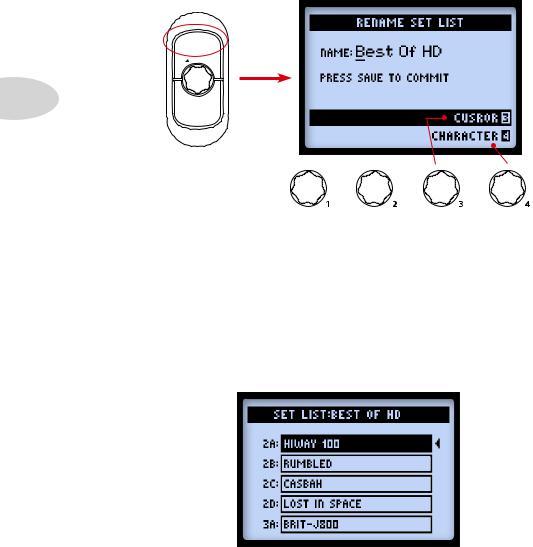
Set Lists & Presets
Rename a Set List: With the desired Set List selected, press the SAVE button to display the Rename Set List screen.
SAVE
PRE
S
E
TS
4•2
HOLD FOR SYSTEM & I/O
VIEW
To edit the Set List name, use Multi-function Knob 3 to select the desired character, then use Knob 4 to edit the character. Once complete, press SAVE again to commit your new name, and you’ll be returned to the Set Lists screen. Or, just press PRESETS button to return to the Set Lists screen without committing any name changes.
Arranging Presets within Set Lists
While in the Set Lists screen, double-press the ENTER button to display the list of Presets in the current Set List, where you can reference each Preset’s Bank/Channel location, load a Preset, or rearrange the Presets into in any order you like.
The Set List - Presets screen
